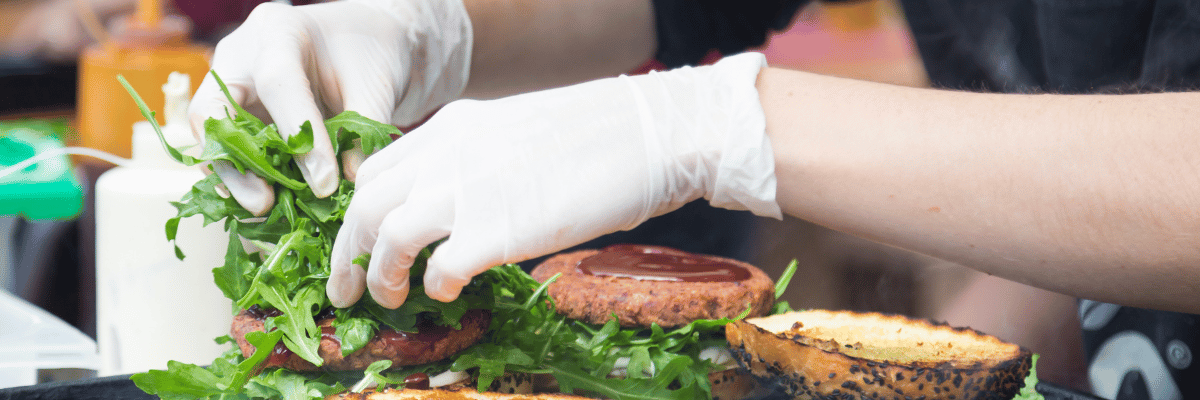Best Sandwich Gloves
Published by Harmony Lab & Safety Supplies on Nov 26, 2025
The Essential Guide to Food Handling Gloves: Disposable vs. Reusable for Kitchen Hygiene
Disposable gloves (often called **sandwich gloves**) are an essential tool in any kitchen, whether you’re a professional chef or a home cook. They offer a crucial layer of protection and hygiene when handling food, especially when making sandwiches, salads, and other hand-held meals. With numerous options available, it can be challenging to determine which **food handling gloves** are the best fit for your needs.
In this comprehensive guide, we’ll explore the different types of **food service gloves**, their materials (Nitrile, Vinyl, Latex), and key features to help you decide and find the perfect pair for your kitchen.
Types of Food Handling Gloves: Disposable vs. Reusable
Several types of food handling gloves are available, each with unique features and benefits. The most common types include:
Disposable Food Service Gloves
Disposable food service gloves are designed for single use and are ideal for maintaining strict hygiene in food preparation, especially when handling raw ingredients or preventing cross-contamination between tasks. These gloves are typically made from latex, nitrile, or vinyl and are sold in bulk, making them the economical choice for professional food establishments.
Featured: Economical Polyethylene Food Service Gloves
**Disposable Food Service Gloves, Plastic Restaurant Glove, 1.25 mil, One Size Fits Most, 100/pack**
The ultimate **low-cost solution** for high-volume, quick-change tasks. Made from thin, clear **polyethylene (plastic)**, these gloves are perfect for quick sandwich assembly and deli work where frequent changes are mandatory for hygiene.
Reusable Kitchen Gloves (Home Use Only)
Reusable gloves are more durable and can be washed and sanitized between uses. They are typically made from silicone, rubber, or neoprene. While reusable gloves offer long-term value and reduce waste at home, they are **not suitable for food service establishments** due to strict federal and state food safety standards regarding cross-contamination and single-use barriers.
Food Handling Glove Materials: Comfort, Protection, and Allergies
The material of your disposable food handling gloves is crucial, as it impacts comfort, dexterity, protection, and compatibility with allergies.
| Material | Primary Benefits | Best For | Allergy Risk |
|---|---|---|---|
| Nitrile | Superior oil/chemical resistance, good dexterity, durability. | Handling greasy foods, mixing, prolonged use, heavy prep. | **Hypoallergenic/Latex-Free** |
| Latex | Snug fit, excellent dexterity, high barrier. | Intricate tasks (if allergies are not a concern). | High (potential for allergic reaction) |
| Vinyl | Economical, latex-free option. | Light, low-dexterity tasks, short-term handling. | **Latex-Free** |
Reusable Materials (Silicone and Neoprene)
For home kitchens, reusable options offer specialized features:
- **Silicone:** Offers excellent heat resistance, making them ideal for handling hot foods or working near heat sources. They are non-stick and easy to clean.
- **Rubber/Neoprene:** Provide heat resistance and excellent grip for heavy-duty kitchen tasks. They are durable but may offer less dexterity than thin disposable gloves.
Features to Consider When Choosing Food Handling Gloves
When selecting the best food handling gloves for your needs, consider the following features:
- Size and Fit: Ensure the gloves fit comfortably and securely on your hands to avoid slipping or discomfort. A snug fit (like Nitrile) offers better dexterity for tasks requiring precision.
- Grip: A good grip is crucial when handling slippery or wet ingredients. Look for gloves with textured surfaces (common on Nitrile and Latex) to ensure a secure hold.
- Durability: For heavy-duty prep or extended use, Nitrile offers higher puncture resistance than Vinyl or Latex.
- Heat Resistance: If you frequently handle hot foods, choose specialized heat-resistant reusable gloves (Silicone/Neoprene) as disposable gloves offer no significant heat protection.
Frequently Asked Questions (FAQs) about Food Service Gloves
- Are food handling gloves required by law in food establishments?
- In many regions, food safety regulations require food handlers to wear gloves when preparing or handling ready-to-eat foods, such as sandwiches, to minimize the risk of contamination. Always check your local and state food safety guidelines for specific requirements.
- How often should I replace my disposable food service gloves?
- Disposable gloves should be replaced after each use, when switching between handling raw and ready-to-eat foods, or immediately if the gloves become torn or contaminated during use.
- How do I clean and maintain my reusable sandwich gloves?
- Reusable gloves are generally cleaned with mild soap and water or wiped down. Always follow the manufacturer’s instructions. **Reminder:** Reusable gloves are only approved for home use, not commercial food service.
- How many gloves does the average deli use each day?
- Food service establishments and deli counters use high volumes of disposable gloves daily, necessitating bulk purchasing. Gloves must be changed frequently to prevent cross-contamination, leading to high daily consumption rates.
Conclusion: Choosing the Best Food Handling Gloves
Whether you’re managing a deli counter or preparing lunch at home, finding the best **food handling gloves** for your specific needs can significantly improve your food safety practices and handling experience. By prioritizing factors such as **latex-free materials** (Nitrile, Vinyl), optimal fit, and required durability, you can make an informed decision and select the perfect pair of gloves to ensure proper hygiene in your kitchen. Happy cooking!


